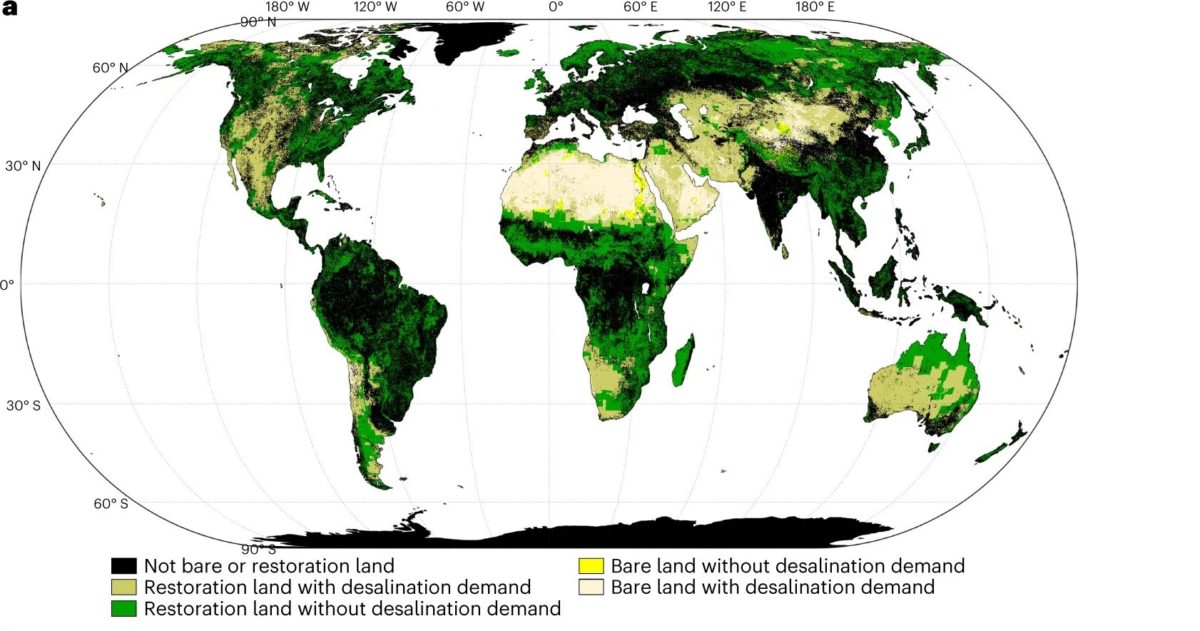Scientists from LUT University in Finland have analyzed the potential of afforestation carbon capture if desalinated seawater would be made available to restore forests in arid or semi-arid areas. They said that PV- and wind-powered seawater reverse osmosis desalination can produce water to maintain enough trees to capture 730 gigatons of carbon dioxide (CO2) between 2030 and 2100.
“This new concept may lead to an additional PV demand of about 10.7 TW and 19,700 TWh of PV electricity,” researcher Christian Breyer told pv magazine.
The team chose a mix of trees in desert and arid climate zones to simulate the carbon capture and water demands of forests grown on dry land between 2030 and 2100. They used the LUT Energy System Transition Model (LUT-ESTM) to analyze the energy requirements of afforestation and to estimate the electricity, water, and global carbon sequestration costs over the 70-year period.
The results show that the world’s areas with the greatest potential are the Middle East and North Africa (MENA), followed by sub-Saharan Africa. These regions have a cumulative CO2 sequestration potential of 131 gigatons and 87 gigatons by 2070, respectively.
”This potential is driven by the availability of restoration and bare land areas with demand for desalination in these regions,” the scientists said.
The regions with the least potential by 2070 are Europe (3.4 gigatons) and Eurasia (1.2 gigatons), due to the low availability of suitable land.
The annual global cost of irrigating and maintaining restored forests with desalinated water has been estimated at €457 ($490) per CO2 ton in 2030. Costs fall to €99 per CO2 ton by 2100. Costs are higher in Afghanistan, Iran, Chad, and Niger, mainly due to water transportation costs that are higher than the global average.
The global average levelized cost of electricity (LCOE) decreases from €46.90 ($50.34)/MWh in 2030 to €31/MWh by 2100. This includes the cost of electricity for continued water supply for irrigating the forests and for powering desalination and water pumping.
“By 2050, countries with CO2 sequestration potential have more than 80% of the corresponding electricity generation from solar PV, highlighting the high solar irradiation levels in regions with afforestation potential,” the academics said.
Battery storage is used to support PV generation during low electricity production, meeting up to 67% of the global electricity demand, according to the study. This solar application could capture 0.26 gigatons of CO2 per year by 2050, improving to 6.7 gigatons of CO2 by the end of the century, claimed the scientists.
The researchers published their findings in “Afforesting arid land with renewable electricity and desalination to mitigate climate change,” which was recently published in Nature Sustainability.
This content is protected by copyright and may not be reused. If you want to cooperate with us and would like to reuse some of our content, please contact: editors@pv-magazine.com.



“The global average levelized cost of electricity (LCOE) decreases from €46.90 ($50.34)/MWh in 2030 to €31/MWh by 2100. This includes the cost of electricity for continued water supply for irrigating the forests and for powering desalination and water pumping.”
By 2060, I would be utterly shocked if solar and storage was not under €20/MWh.
By 2100? 50 – 75% below that again.
Just look at what the actual experts on solar actually say, and the history of total underestimation of installs and cost reductions.
10 Tw will probably be the average annual install by 2040.